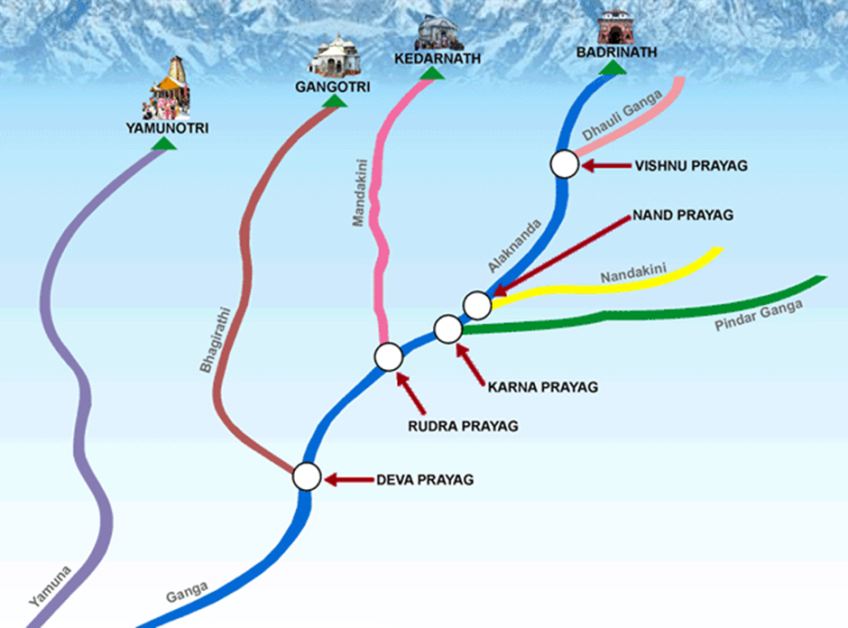
Ganga River System: Northern India is home to the Ganges (Ganga) River, which is revered by Hindus. The Ganges River Basin, which feeds the river, is home to more than 400 million people in India. An area that is drained by a river, like the Ganges, and any of its tributaries is known as a river basin. It follows that rain and surface water from the basin area drain into the nearby rivers.
Origin of Ganga River
- At Gomukh, the end of the Gangotri Glacier, in the Himalayan Mountains, the Ganges River begins.
- The Bhagirathi River’s crystal-clear waters are formed when this glacier’s ice melts.
- The Bhagirathi River officially becomes the Ganges River when it joins the Alaknanda River as it runs over the Himalayas. The adjacent Brahmaputra and Meghna rivers are included in a wider river basin that is frequently thought to include the Ganges River Basin.
- It is one of the biggest river systems in the world and is referred to as the Ganges-Brahmaputra-Meghna (GBM) River Basin.
Tributaries of Ganga
- Major Tributaries of the River Ganga under Upper Ganga Basin Organization are as follows:
- Bhagirathi
- Alaknanda
- Ramganga
- Ghaghra
- Gomti
- Left bank tributaries of Ganga: Ramganga, Garra, Gomati. Ghaghara, Gandak, Burhi Gandak, Koshi, Mahananda
- Right bank tributaries of Ganga: Yamuna, Tamsa, Karamnas, Sone, Punpun, Falgu, Kiul, Chandan, Ajoy, Damodar, Rupnanrayan.
Some tributaries of Ganga and their description is given below:
| Tributaries | Description |
| The Yamuna | The Ganga’s longest and westernmost tributary is the Yamuna. The Yamunotri glacier, which is located on the western side of the Bandarpunch range, is where the Yamuna originates. It merges with Ganga in Prayag. Uttar Pradesh, Himachal Pradesh, Haryana, Delhi, and Uttarakhand are among the states through which the Yamuna flows. |
| The Chambal | It begins in Mhow on the Madhya Pradesh Malwa plateau and runs down a gorge northward toward Kota in Rajasthan, where the Gandhi Sagar Dam has been built. The Chambal River is well-known for the Chambal ravines, which are a type of badland terrain. Following stops in Bundi, Sawai Madhopur, and Dholpur, the Chambal eventually meets the Yamuna. |
| The Gandak | The Gandak River, which consists of the streams Kaligandak and Trisulganga, drains the central region of Nepal. It begins in the Himalayas of Nepal between Dhaulagiri and Mt. Everest. It enters the Ganga plain in the Champaran district of Bihar. It joins the Ganga at Sonpur, which is close to Patna. |
| The Ghaghara | The Ganga River and the Ghaghara River both stem from the Mapchachungo Glacier. |
| The Kosi | Arun, the main Kosi stream, rises in Tibet to the north of Mount Everest; after traversing Nepal’s Central Himalayas, it is joined by the Son and Tamur Kosi streams in the west and east, respectively; it then merges with Arun to form Sapt Kosi; and finally, it joins the Ganga in the Bihar district of Katihar. |
| The Ramganga | Near Gairsain, in the Garhwal hills, the river has its source. It merges with the Ganga close to Kannauj. |
| The Sarda or Saryu | The river Saryu, also known as Goriganga, originates in the Milan Glacier in the Nepalese Himalayas.It joins the Ghaghra at the Indo-Nepal border, where it is known as Kali or Chauk. |
| The Mahananda | The Ganga’s final left bank tributary in West Bengal is the Mahananda River, which originates in the Darjiling Hills. |
| Damodar River | It is located on the eastern edge of the Chhota Nagpur plateau and enters the Hugli River after flowing through a rift valley.The Barakar River is the principal tributary of the Damodar River, which was formerly known as the Sorrow of Bengal and is now under the authority of the Damodar Valley Corporation, a multipurpose enterprise. |
| Son | The Son River joins the Ganga near Patna in Bihar and is the main right-bank tributary of the Ganga. It starts in the Amarkantak Plateau in Madhya Pradesh. |
Location
- India makes up over 79% of the Ganga basin’s area. Uttarakhand, U.P., M.P., Rajasthan, Haryana, Himachal Pradesh, Chhattisgarh, Jharkhand, Bihar, West Bengal, and Delhi are among the 11 states that make up the basin.
- With a catchment area of 26% of India’s total land area and a population of around 43%, the Ganga basin is the largest river basin in that nation.
- The five major states on the main stem of the Ganga River—Uttarakhand, Uttar Pradesh, Jharkhand, Bihar, and West Bengal—are the present focus of NMCG’s National Ganga River Basin Projects (NGRBP), which are supported by the World Bank.
States: Uttarakhand and Uttar Pradesh, Madhya Pradesh and Chhattisgarh, Bihar and Jharkhand, Rajasthan, West Bengal, Haryana, Himachal Pradesh, Delhi
Topography
The Ganga basin comprises three large topographic divisions of the Indian subcontinent, namely the Himalayan Young Fold Mountains, the Gangetic Plain, and the Central Indian highlands. Each of these peaks is surrounded by snow fields and glaciers. All
the tributaries are characterized by well-regulated flows and an assured supply of water throughout the
year by these glaciers. The Gangetic plains, in which the main stem of Ganga lies, situated between
the Himalayas and the Deccan plateau, constitute the most of the sub-basin ideally suited for
intensive cultivation. It consists of alluvial formation and is a vast flat depositional surface at an elevation below 300m. The Central highlands lying to the south of the Great Plains consists of mountains, hills and plateaus intersected by valleys and river plains. They are largely covered by forests. Aravali uplands, Bundelkhand upland, Malwa plateau, Vindhyan ranges and Narmada valley lies in this region.
The Gangetic plains are mostly divided into three parts, Upper Ganga plains, Middle Ganga plains and Lower Ganga plains. The Upper Ganga plain is the part of the Great Plains lying approximately between the Yamuna in the west covering the parts of Uttarakhand and Uttar Pradesh. The region is delimited in the north by 300m contour which separates it from the Garh – Kum Himalaya west of Sarda while the International boundary of Nepal marks the limit towards the east. In the south the
Yamuna demarcates its border with the Bundelkhand. The axis of the topographic trough
paradoxically lies nearer the peninsular block or along the Ganga which traverses the area in a
south-southeasterly direction. Thus there is, though not perceptible, a tract adjacent to the foot hills where the slope is higher and has resulted in the preponderance of numerous small streams,
assigning a somewhat medium to fine texture to this part. The southern counterparts, particularly north of the Ganga are characterized by the sluggishly-flowing streams like the Ramganga and the Ghaghara studded with ox-bows, sandy stretches etc. The topographic diversities produced by the changing river courses are predominantly observed in the Ramganga and the Ghaghara valleys, particularly in their flood plains.
Ganga river system
The river Ganga is a transboundary river of Asia that flows through India and Bangladesh. In Bangladesh, it is known as the river Padma.
The Ganga River system is the largest river system in India having an area of 8.6 lakh sq km consisting of perennial and non-perennial rivers which originates in the Himalayas in the North and the Indian Peninsula in the South.
Flow of River Ganga
The melting water from the Himalayas, as well as water from tributaries and rainfall, all feed the sacred river. The Ganges flows south and east from the Himalayas, forming a canyon as it leaves the mountain. It winds its way through northern India, eventually emptying into the Bay of Bengal. The Ganges’ many tributaries originate from the nearby countries of Nepal, Bangladesh, and China.
Five Prayags (Panch Prayag):
Prayag means the ‘Place of the confluence of a river’. The source of Alakhnanda is in the Satopath glacier above Badrinath. The river Alakhnanda is joined by its tributaries and forms important pilgrimage sites Known as five Prayags (Panch Prayag).

The Panch Prayag are as follows:
Vishnuprayag: Dhauliganga (Originates from Niti Pass) joins the Alaknanda near Joshimath on the Badrinath route. Dhauli Ganga originates from Niti pass, after traveling a distance of 25 km from Vishnu Prayag.
Nandprayag: Nandakini joins the Alaknanda. The Nanda Prayag is second prayag.
Karnprayag: Pindar River joins the Alaknanda River
Rudraprayag: River Mandakini joins the Alaknanda
Devprayag: Bhagirathi joins the Alaknanda to form Ganga in Garhwal division of state Uttarakhand.
Programs for Ganga
- National Ganga River Basin Authority (NGRBA)
National Ganga River Basin Authority (NGRBA) has started the Mission Clean Ganga with a changed and comprehensive approach to champion the challenges posed to Ganga through four different sectors, namely, of wastewater management, solid waste management, industrial pollution and river front development.
NGRBA has been established with the objectives of (a) ensuring effective abatement of pollution and conservation of the river Ganga by adopting a river basin approach to promote inter-sectoral co-ordination for comprehensive planning and management; and (b) maintaining environmental flows in the river Ganga with the aim of ensuring water quality and environmentally sustainable development.
NGRBA is mandated to take up regulatory and developmental functions with sustainability needs for effective abatement of pollution and conservation of the river Ganga by adopting a river basin approach for comprehensive planning and management. The Ministry of Water Resources, River Development and Ganga Rejuvenation (MoWR, RD & GR) is the nodal Ministry for the NGRBA. The authority is chaired by the Prime Minister and has as its members the Union Ministers concerned, the Chief Ministers of the States through which Ganga flows, viz., Uttarakhand, Uttar Pradesh, Bihar, Jharkhand and West Bengal, among others.
- Namami Gange Programme
Namani Gange Programme is an integrated conservation Mission, approved as a “Flagship Programme” by Union Government in June 2014. Namami Gange Programme is an Integrated Conservation Mission, approved as a ‘Flagship Program’ by the Union Government in June 2014 with a budget outlay of Rs.20,000 Crore to accomplish the twin objectives of effective abatement of pollution, conservation, and rejuvenation of National River Ganga.
The program would be implemented by the National Mission for Clean Ganga (NMCG), and its state counterpart organizations i.e., the State Program Management Group (SPMGs).
In order to implement the “Namami Gange” Program, a three-tier mechanism has been proposed for project monitoring comprising of:
A high-level task force chaired by Cabinet Secretary assisted by NMCGat the national level,
A state-level committee chaired by Chief Secretary assisted by SPMGat the state level and
District level committee chaired by the District Magistrate.
Significance of River Ganga
The Ganga is India’s most important and iconic river. It flows down from its glacial source in the high Himalayas to course through five states in the northern plains before draining into the swirling waters of the Bay of Bengal through the Sunderbans delta, the largest mangrove system in the world.
The Ganges River carries nutrient rich sediment as it flows, depositing fertile soil along its shores. This has allowed civilizations to develop and thrive along the waterway for centuries. Today, the river flows through well-populated regions of India, providing freshwater to the millions of people living in these regions. The river is also used for fishing, irrigation, and bathing, and it is worshiped in the Hindu religion as the Mother Ganga. As the river empties into the Bay of Bengal, the mouth forms the Ganges River Delta, the largest river delta in the world.
The Ganges River is a vital resource to Asia, but it faces many threats. Human and industrial pollutants fill the river in some areas, making it unsafe even for swimming. As the population in regions surrounding the river swells, water demands for agriculture increases, straining water levels. Adding further stress to the situation, scientists have concluded that climate change has led to a decrease in glacial ice in the Himalayas, the source of the Ganges, and theorize this will result in further decreased water levels in the river over time.
You Can Read Also:
Multidimensional Poverty Index – Full Form, Facts, Notes
Formal Letter In English
NITI Aayog (National Institution for Transforming India)





